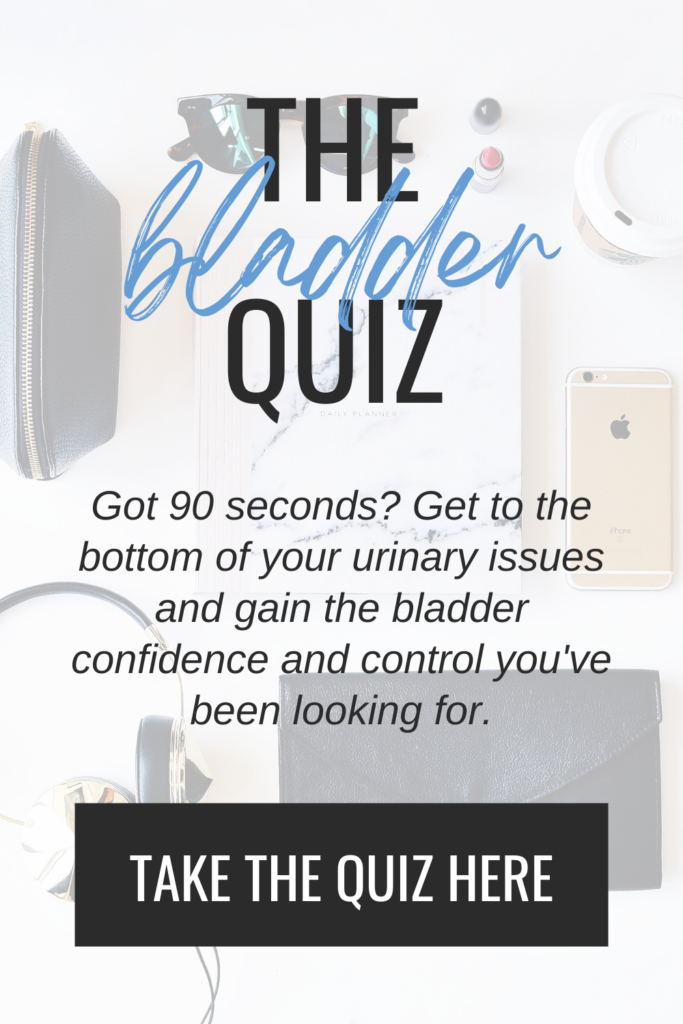Maybe it’s my unique interests or less than normal internet search habits, but I can’t scroll social media, watch a rom-com, or read a fiction novel without ~someone~ mentioning urine leakage. I can’t say I’m surprised…one in three women report experiencing bladder incontinence, and it’s likely even more deal with it silently. When it’s mentioned in the books, movies, and Instagram’ stories, that “little bit” of leakage with a cough or sneeze, laugh til you pee snafu, and can’t unbutton your pants fast enough phenomenon is either quickly shrugged off or chuckled away and almost always followed by a remark about kegels.
If you’ve never heard of kegels, it’s a slang term given to the act of contracting the pelvic floor. And the pelvic floor is a sling of muscles that sit in the bottom of the pelvis and control sexual, bowel, and bladder function as well as support the spine and pelvis. Termed by Arnold Kegel, an American gynecologist in 1948, kegels are commonly used to strengthen the pelvic floor and decrease or prevent incontinence and other bladder issues.
That being said, kegels are the popular girl, the Regina George if you will, according to doctors, influencers, and best friends alike. And if you have bladder problems like urinary leakage, urgency, frequency, or prolapse (or want to prevent any and all of the above in the future), you too may have tried your hand at kegels in the hopes of gaining pelvic floor strength and its benefits.
But if those magical little pelvic floor contractions just don’t seem to be cuttin’ it…you’re not alone. As a pelvic rehab therapist, I regularly hear patients boasting of their kegel efforts (yay!), but with no improvement in their bladder issue to show for it (booo!).
So why don’t kegels work? Well…they do! There’s just ~significantly~ more to an effective kegel than sitting and squeezing your pelvic floor continually and as hard as physically possible.
If you’ve tried kegels with minimal results or have bladder concerns but no idea where to start, keep reading! This take on why your kegels have been unsuccessful thus far mayyyyyyy be just what you need to finally see improvement
YOUR PELVIC FLOOR IS TOO TIGHT
Boom! Let’s kick things off with a bang because it’s my life goal to banish the myth that a “tight vagina” is a good thing…especially when it comes to the bladder. Tight and strong are not synonymous, and if the pelvic floor is tight, it can lead to bladder dysfunction (aka the urine leakage, urgency, frequency, and prolapse we’ve been talking about) as well as pelvic pain, pain with intercourse, constipation, period pain, and back pain to name a few.
If you have pelvic floor tightness, kegels are the ~last~ thing you should be doing.
I think of it like a fist – the hand should be able to make a fist, but it shouldn’t be stuck in a fist. A hand stuck in a fist is painful, weak, and dysfunctional. If my hand was stuck in a fist, squeezing a stress ball til kingdom come wouldn’t help, right!?! No! You would help me relax my hand…then strengthen it.
RELATED POST: My Daily Pelvic Floor Relaxation Routine + Why You Might Want to Try it Too
Believe it or not, learning to relax the pelvic floor is (1) often the first step to fixing bladder issues and (2) actually more important than kegels *gasp*. You can grab my FREE, 4-step guide to relaxing the pelvic floor here. Just promise me you’ll act surprised when your pelvic floor gets stronger with a bit of breathing, plenty of muscle releasing, a few stretches, and without ever doing a kegel.
YOU’RE NOT DOING KEGELS CORRECTLY
If those infamous kegels have you just plain stumped, you’re in good company. Studies show that half of women with bladder complaints can’t perform a kegel properly. So unless you’ve received training or guidance from a reliable source, it’s possible you may be doing them wrong.
In my pelvic rehab clinic, I always teach and have patients practice kegels with either my finger inserted vaginally or placed at the perineum depending on personal preference. You and I don’t have that luxury here, but I’m hopeful that a bit more education will be just what you need to succeed.
There are three layers of muscle in the pelvic floor, and they all need to be activated in order for a kegel to be 100% effective. A kegel is a squeeze and lift of the pelvic floor with the first two layers performing the squeeze and the third layer performing the lift. A few images that work well for most include:
- Lifting a marble
- Picking up a grape
- Slurping spaghetti
- Bringing your pubic bone and tail bone closer together
- Closing the elevator doors and raising the elevator up into the building
- Pulling your underwear up an in
Once you achieve both the squeeze and lift, you can be confident in your ability to engage the entire pelvic floor. Then…don’t forget to fully relax at the end *wink wink*.
Now, a really good, dare I say ~perfect~, kegel also involves timing of breath, consideration of your glute and abdominal muscles, your body’s position, and more. For alllllllll that info, you’ve gotta download the Ultimate Guide to Kegels, a printable, actionable, where-has-this-been-all-my-life roadmap to just about everything you need to know you’re doing kegels properly.
YOU’RE NOT DOING THE RIGHT AMOUNT
Just like any exercise (literally any and every exercise) there’s an optimal amount you should do for your personal fitness level and goals. Too many of any given movement can hurt you, and too little may not be challenging enough and risks wasting your time. Kegels are no different, and it’s important you do the right amount of pelvic floor contractions to see results.
Doing kegels with no parameters or strategy behind the type of kegel you’re doing (yes…there are multiple) will yield outcomes that are just as random. The Ultimate Guide to Kegels I shared above walks you through finding your personal kegel prescription, and that level of precision plus the Easy Kegel App is my favorite combo for DIY pelvic floor strengthening.
RELATED POST: A Pelvic Rehab Therapist’s Guide to Popular Pelvic Floor Strengthening Tools
RELATED POST: 13 Smartphone Apps Every [Health-Conscious] Woman Needs on Her Home Screen
Once there’s clarity around kegel sets, repetitions, and frequency, confidence and consistency in your pelvic floor strengthening efforts are bound to pay off. Whatever you do, don’t skip this step. It’s a must.
POOR TIMING
As odd as it might seem, I think of kegels like bicep curls. It’s a single, overallllllll straight forward muscle contraction that you do in isolation to increase strength. But bicep curls (and therefore kegels) need to be performed in conjunction with other activities to improve their effectiveness and functionality.
Practicing kegels in reps and sets are a great way to build pelvic floor strength, but integrating them throughout the day with activities of daily living are where you’ll see the best bang for your buck.
So what, when, and where is the best time to incorporate kegels? Well…it’s different for everyone based on their bladder issues. But of course I’ve got you! I’ve created a quiz that takes less than two minutes to complete and tells you exactly when to do your kegels to see improvement in your specific bladder concerns. Click here to take the quiz now with immediate answers to your bladder issues and a customized kegel guide right to your inbox.
POSTURE
Whenever I talk about posture, I immediately hear my mom reminding 13-year-old Amanda to stand up straight and it makes me both smile and cringe simultaneously. Per usual, she was right, because good posture plays a large role in so many aspects of health, and pelvic floor strength is no exception.
All muscles are strongest at their mid range. Referring back to the bicep – this is why we bend our elbows to load our arms with groceries and hulk them into our homes. To get a bit scientific (but not tooooo nerdy), there are optimal muscle fiber connections at a muscle’s mid range.
The pelvic floor is no different, and maintaining neutral pelvic posture puts the pelvic floor muscles at their mid range and enhances kegel efforts. An anterior pelvic tilt (booty stuck out the back) promotes muscle elongation, and a posterior pelvic tilt (booty tucked in) causes muscle shortening, both of which make the muscles harder to contract and cause ineffective kegels.
RELATED POST: Strengthen Your Pelvic Floor With Zero (Yes…Zero) Kegels a Day – Here’s How
Maintaining good posture with your ears, shoulders, hips, and ankles stacked while practicing kegels will help you get the most out of your contractions. A neutral pelvis will not only help you feel the contraction more, but will also carry over to those functional activities mentioned above. While keeping good posture isn’t always easy, it’s one of the most accessible things to check as you troubleshoot your kegels.
Whew! I had no idea one person could type the word “kegel” so many times. I think it’s one of those words that sounds weirder the more you say it… “kegel, kegel, kegel, kegel, kegel”…don’t you think?
As you can see, kegels are not the one-size-fits-all fairy dust that many make them out to be. They take strategy, mindfulness, awareness, aaaaaand a bit of practice to get them down pat. Not to be a Negative Nancy, but anyone who tells you otherwise likely isn’t aware of everything that goes into true pelvic floor strengthening.
If…big if…kegels are right for you (head back up to our talk on pelvic floor tightness if you’re not quite sure), then these tips and strategies are exactly what you need to make your kegel efforts a smashing success. And if you still feel like you need some guidance piecing everything together, or you try all of the above and are still struggling, you’ve gotta check out my online course, The Bladder Blueprint, which is the step-by-step roadmap you need to achieve ultimate bladder healing.
Everyone deserves a bladder they can count on, and kegels are one of the many ways to get there. Now you can confidently move forward in your pelvic floor strengthening practices and get back to the things your bladder was holding you back from – in the cute-colored leggings, sans pads, head held high, and most importantly…leakage free.
– Amanda
Disclaimer: The content provided here does not constitute medical advice, nor is it a substitute for personalized healthcare. If you have concerns about a medical condition, diagnosis, or treatment, you should consult with a licensed healthcare professional.



















